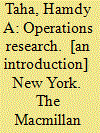| Srl | Item |
| 1 |
ID:
041259


|
|
|
|
|
| Publication |
New York, The Macmillan Company, 1971.
|
| Description |
xvi, 703p.Hbk
|
|
|
|
|
|
|
|
|
|
|
|
Copies: C:1/I:0,R:0,Q:0
Circulation
| Accession# | Call# | Current Location | Status | Policy | Location |
| 008741 | 658.4034/TAH 008741 | Main | On Shelf | General | |
|
|
|
|
| 2 |
ID:
138625


|
|
|
|
|
| Summary/Abstract |
This paper presents formulation and solution of long range flight vehicle and tactical air-to-air flight vehicle trajectory optimisation. The first case study is of a long range flight vehicle. Here an optimum steering program during powered phase has been evolved as control input for achieving maximum range with available propulsions in the presence of path and terminal constraints. The second case study is of a tactical flight vehicle for air-to-air application. Here a minimum flight time trajectory has been generated for covering a specified range pertaining to a specified air-to-air engagement by evolving pitch lateral acceleration as control input. Here also, there are many path and terminal constraints consisting of launch aircraft, pursuer, and evader. The studies have been carried out as part of system design activity of both flight vehicles. Both are real-life optimisation problems under several constraints. Through it is very difficult to solve such practical problems in flight dynamics using classical optimal control theory, it has been solved successfully using direct transcription method based on nonlinear programming. Rapid convergence has been achieved in four passes with minimum grids in first pass, to start with, and increasing the grids in subsequent passes. Solving such a real-life problem with proper convergence subjected to many constraints is claimed as novelty of present research.
|
|
|
|
|
|
|
|
|
|
|
|
|
|
|
|